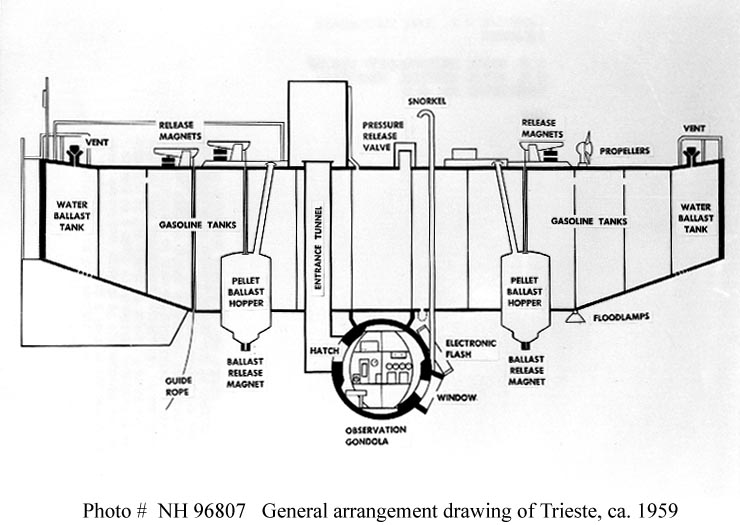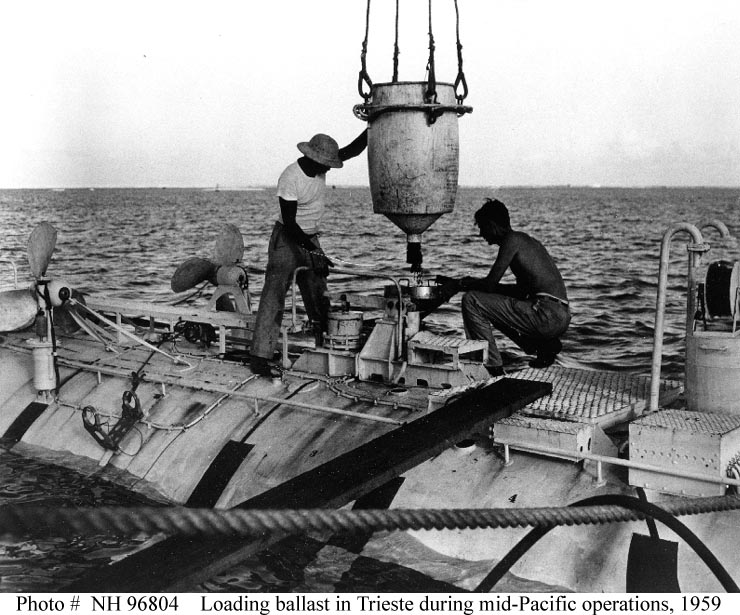This Place is the Challenger Deep the deepest surveyed point in the oceans, located in the Mariana Islands group at the southern end of the Mariana Trench.

This is the story of one of my heros, Jacques Piccard one of only 2 men to ever reach this place.

Jacques Piccard (born July 28, 1922) is a Swiss explorer and engineer, known for having developed underwater vehicles for studying ocean currents. He is the only person (as of 2008), along with Lt. Don Walsh, to have reached the deepest point on the earth's surface, the Challenger Deep, in the Mariana Trench.
Jacques Piccard was born in Brussels, Belgium to Auguste Piccard, who was himself an adventurer and engineer.

On January 23, 1960, Jacques Piccard and Don Walsh reached the ocean floor in the Challenger Deep with his bathyscaphe Trieste. The depth of the descent was measured at 10,916 meters (35,813 feet), later more accurate measurements in 1995 have found the Challenger Deep to be less deep at 10,911 m (35,797 ft). The descent took almost five hours and the two men spent barely twenty minutes on the ocean floor before undertaking the 3 hour 15 minute ascent.

The Challenger Deep is the deepest surveyed point in the oceans, with a depth of about 11,000 metres (about 36,000 feet). It is located in the Mariana Islands group at the southern end of the Mariana Trench. The closest land is Fais Island, one of the outer islands of Yap, 289 km southwest and Guam 306 km to the northeast. The point is named after the British Royal Navy survey ship HMS Challenger, which first surveyed the trench in 1951.
The maximum surveyed depth of the Challenger Deep is 10,923 meters (35,838 feet) or 6.7875 miles. (National Geographic puts the depth at 10,920.07 meters (35,827 feet) below sea level.) The pressure at this depth is approximately 1,095 times that at the surface, or 110 MPa.
The HMS Challenger Expedition (December 1872 – May 1876) first sounded the depths now known as the Challenger Deep. This first sounding was made on 23 March, 1875 at station 225. The reported depth was 4,475 fathoms (8,184 m, 26,850 ft), based on two separate soundings.
A 1912 book, The Depths of the Ocean by Sir John Murray, records the depth of the Challenger Deep as 31,614 feet (9,636 meters). Sir John was one of the Expedition scientists, a young man at the time. Page 131 of Murray's book refers to the Challenger Deep. All of the original reports of the Challenger expedition can be viewed on the web at the Challenger Library.

In 1951, about 75 years after its original discovery, the entire Mariana Trench was surveyed by a second Royal Navy vessel, also named HMS Challenger after the original expedition ship. During this survey, the deepest part of the trench was recorded using echo sounding, a much more precise and vastly easier way to measure depth than the sounding equipment and drag lines used in the original expedition. HMS Challenger measured a depth of 5,960 fathoms (10,900 m, 35,760 ft) at [show location on an interactive map] 11°19′N, 142°15′E.
On 23 January 1960, the Swiss-built Bathyscaphe Trieste, acquired by the U.S. Navy, descended to the ocean floor in the trench manned by Jacques Piccard (who co-designed the submersible along with his father, Auguste Piccard) and USN Lieutenant Don Walsh. The descent took almost five hours and the two men spent barely twenty minutes on the ocean floor before undertaking the three-hour-and-fifteen-minute ascent. They measured the depth as 10,916 metres (35,813 feet).

In 1984, a Japanese survey vessel using a narrow, multi-beam echo sounder took a measurement of 10,924 meters (35,838 feet).
On their 1960 descent, the crew of the Trieste noted that the floor consisted of diatomaceous ooze and reported observing "some type of flatfish, resembling a sole, about 1 foot long and 6 inches across" lying on the seabed. The fish sighting has since been questioned by some, however, with suggestions that it may possibly have been a sea cucumber. The video camera on board the Kaiko probe spotted a sea cucumber, a scale worm (a type of bristle worm) and a shrimp at the bottom.
An analysis of the sediment samples collected by Kaiko announced the discovery of large numbers of simple organisms at 10,900 metres water depth.[8] While similar lifeforms have been known to exist in shallower ocean trenches (>7,000 m) and on the abyssal plain, the lifeforms discovered in the Challenger Deep possibly represent taxa independent from those in shallower ecosystems.
Out of the 432 organisms collected, the overwhelming majority of the sample consisted of simple, soft-shelled foraminifera, with four of the others representing species of the complex, multi-chambered genera Leptohalysis and Reophax. Overall, 85% of the specimens consisted of organic soft-shelled allogromids. This is unusual compared to samples of sediment-dwelling organisms from other deep-sea environments, where the percentage of organic-walled foraminifera ranges from 5% to 20% of the total. As small organisms with hard calcated shells have trouble growing at extreme (10,000 m) depths because the water there is severely lacking in calcium carbonate, scientists theorize that the preponderance of soft-shelled organisms at the Challenger Deep may have resulted from the typical biosphere present when the Challenger Deep was shallower than it is now. Over the course of six to nine million years, as the Challenger Deep grew to its present depth, many of the species present in the sediment died out or were unable to adapt to the increasing water pressure and changing environment. The remaining species may have been the ancestors of the Challenger Deep's current denizens.
Trieste was a Swiss-designed deep-diving research bathyscaphe ("deep boat") with a crew of two people, which reached a record-breaking depth of about 10,900 metres (35,761 ft), in the deepest part of any ocean on earth, the Challenger Deep in the Mariana Trench, in 1960. The dive has never been repeated, and presently no crewed or uncrewed craft exists capable of reaching such depth.
Trieste departed San Diego on October 5, 1959 on the way to Guam by the freighter Santa Maria to participate in Project Nekton — a series of very deep dives in the Mariana Trench.
On January 23, 1960, Trieste reached the ocean floor in the Challenger Deep (the deepest southern part of the Mariana Trench), carrying Jacques Piccard (son of Auguste) and Lieutenant Don Walsh, USN. This was the first time a vessel, manned or unmanned, had reached the deepest point in the Earth's oceans. The onboard systems indicated a depth of 11,521 metres (37,799 ft), although this was later revised to 10,916 metres (35,814 ft), and more accurate measurements made in 1995 have found the Challenger Deep to be slightly shallower, at 10,911 metres (35,797 ft).

The descent took 4 hours and 48 minutes before reaching the ocean floor. After passing 9,000 meters one of the outer Plexiglas window panes cracked, shaking the entire vessel.The two men spent barely twenty minutes at the ocean floor, eating chocolate bars to keep their strength. The temperature in the cabin was a mere 7°C (45°F) at the time. While on the bottom at maximum depth, Piccard and Walsh (unexpectedly) regained the ability to communicate with the surface ship, USS Wandank II (ATA-204), using a sonar/hydrophone voice communications system. At a speed of almost a mile per second (about five times the speed of sound in air), it took about 7 seconds for a voice message to travel from the craft to the surface ship, and another 7 seconds for answers to return.
While on the bottom, Piccard and Walsh observed small soles and flounders swimming away, proving that certain vertebrate life can withstand all existing extremes of pressure in earth's oceans. They noted that the floor of the Challenger Deep consisted of "diatomaceous ooze".
After leaving the bottom, they undertook their ascent, which required 3 hours, 15 minutes. Since then, no manned craft has ever returned to the Challenger Deep. A Japanese robotic craft Kaiko reached the bottom of the Challenger Deep in 1995. This craft was lost at sea in 2003, leaving no craft in existence capable of reaching these most extreme ocean depths.
Surely this is the stuff of Dreams?

No comments:
Post a Comment